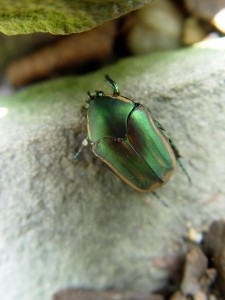Banner July for June Beetle
July 9th, 2013
It’s the biggest yard bug I know of this side of Africa – the thumb-sized, shiny-green June beetle.
I’m hearing reports from some locals that they’re seeing more of them swarming around in the last week than ever before.
It must have been a banner year for June-beetle baby-making.
June beetles are scary-looking things.
Besides their sheer size, they make a buzzing sound that causes people to think they’re stinging bugs – something akin to a bumble bee dressed in green metal armor.
June beetles don’t sting, but they’re clumsy fliers and may well crash into your forehead.
In usual numbers, they’re more of a minor nuisance than anything. But when numbers swell like they apparently have in some areas this summer, they can actually do some significant lawn damage.
One Dauphin County gardener told me she’s got swarms of June beetles over-flying brown patches of what used to be her green lawn.
In that regard, June beetles are somewhat like the better-known Japanese beetle.
Their main threat is lawn damage from the root-eating larval stage called “grubs.”
Since June beetles are about four times the size of a Japanese beetle, it makes sense that their grubs also are bigger. Like Japanese beetles, the adults lay eggs in mid-summer that hatch into young grubs that feed underground in fall, then burrow deeper over winter, then resume feeding higher up in spring.
Given enough numbers, the finger-sized June beetle grubs can eat enough lawn roots and even blades to cause the kind of damage some gardeners are seeing. They can also make annoying bumps in the lawn.
I wouldn’t take it for granted, though, that June beetles have browned out a lawn just because you see a few of them flying around. Many other things can brown out lawns.
A tell-tale sign of grub damage is if the brown patches pull up in rootless patches.
Another sign of the June beetle grub is mounds and tunnels in the soil. Like the grubs themselves, they’ll be finger-sized as well. Pretty noticeable.
In spring and fall, you can catch June beetle grubs in the act by digging out a section of suspicious turf a foot deep and a foot square. Look for big, fat, creamy-white yuckies that are bigger than any Japanese beetle grub you’ve seen.
You won’t find grubs in the ground this time of year, though. They’ve pupated into the green adults that are flying around.
July is actually their biggest adult month most years, even though they’re called June beetles.
I’d just figure on replanting any dead grass for now and not try to spray anything on the adults.
A better time/way to control this bug – if you even deem it necessary – is to go after the grub stage.
For organic gardeners, biological controls in the form of Steinernema and Heterorhabditis nematodes are two living organisms you can buy and apply to the ground that will feast on beetle grubs. Late summer into early fall is the best time to apply these. (Garden centers occasionally sell them, or you can buy “good bugs” at organic gardening catalogs such as Gardens Alive.)
I’ve heard that milky spore disease (a more common organic approach) isn’t very effective on grubs other than Japanese beetles.
If you’re OK with chemicals, young June beetle grubs are susceptible to the two old-standby grub-killers: Sevin (carbaryl) and Dylox (trichlorfon). These also work best when applied in late summer to early fall.
Read the label carefully before buying or using any insecticides.
Ohio State Extension has an excellent fact sheet on controlling June beetles that describes a few curious intricacies, including the fact that if you apply grub-killers to a major infestation of June beetle grubs in spring (when they’re full grown), you could end up with one heckuva stinky situation with decaying, dead grubs laying over the top of the lawn.
I haven’t been able to get a solid read on how well the usual Japanese beetle preventers (i.e. imidacloprid and halofenazide) do at stopping grubs before they get started.
These are ones most people apply in June or July to kill the next generation of beetles as soon as they hatch.
One source I read claims this class of chemicals doesn’t work very well against June beetle grubs when applied that early, but it may work reasonably well if applied in August or September.
I have no first-hand experience either way.
My approach to beetle grubs is that I’ll generally let nature take its course and just reseed the lawn in years when the grubs are bad.
But as for the June beetle adults we’re seeing now, my organic control of choice is a tennis racket.
You can wipe out a fair number of them by whacking the swarms.
It’s also good exercise and might help hone your tennis game.








